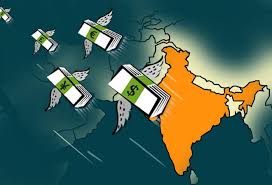Why foreign investors are losing interest in India

IT WOULD BE wrong to say that the only people who attended English county cricket in the 1980s were scoreboard enthusiasts, old men with flasks of cold tea and red-faced types there for the all-day bar. A few oddballs went to watch the cricket. A big draw was Graeme Hick, a Zimbabwe-born batsman and a relentless runmaker for Worcestershire. He eventually qualified to play for England in 1991. In front of bigger crowds and faster bowling, he could not reproduce his blistering county form.
In cricket-mad India, a parallel might be drawn between Mr Hick and Narendra Modi, the prime minister. Mr Modi was also the object of high hopes. He was elected with a thumping majority in May 2014 on his record in Gujarat, a well-run Indian state. But on the bigger stage, the form he showed as a state minister has often deserted him. A recent clash with the central bank, the Reserve Bank of India (RBI), that led to the resignation of its governor, Urjit Patel, is the latest—and most serious—mis-step.
The rupee fell after Mr Patel resigned. But India under Mr Modi has been one of the more stable emerging markets. The stockmarket has seemed to defy gravity, thanks in large part to domestic investors steadily switching from gold and property into shares. That buying has masked the disquiet among foreign investors, who have quietly pulled money from India. The sense that Mr Modi has blown a good chance to transform India is widespread.
The hallmarks of Mr Modi’s 12 years in Gujarat were ambitious projects run by honest civil servants. The results are tangible. The roads around Ahmedabad, the state’s commercial capital, are excellent. The water supply is abundant. Gujarat’s 18,000 villages are connected to the electricity grid. Gujarat was already a state with lots of factories and formal jobs. One of Mr Modi’s innovations was to use IT to cut through red tape for new businesses. He was project-manager-in-chief. A handful of trusted civil servants gave orders. Those further down the chain of command were held to account.
Mr Modi excels in this “project mode”, says Reuben Abraham of the IDFC Institute, a think-tank. Judged by the number of toilets installed or kilometres of road laid, his time in the top job is a success. India’s GDP growth rate of 6-7% on his watch is not too shabby. Yet for a poor country with a fast-expanding population, 6-7% growth is a baseline. A government in project mode will not lift it. “You need deeper, systemic reforms,” says Mr Abraham. Those require a coherent strategy and policymakers capable of adapting it as conditions change. This is at odds with Mr Modi’s command-and-control style.
His defenders point to some big-bang reforms. A national goods-and-services tax (GST) has replaced a mosaic of national, state and city levies that were a barrier to trade within India. The country has a newish bankruptcy code. The central bank has an inflation target and a monetary-policy committee. But these were ideas bequeathed by the previous administration. The single Modi-branded policy—cancelling high-value banknotes to crush the black economy—probably did more harm than good.
And progress has been set back by the clash with the RBI. The government pressed it to remit more of its reserves and to go easy on state-owned banks with bad debts. There are two sides to every dispute. Central bankers have a habit of standing on their dignity while dodging accountability. But Mr Patel was clearly sinned against. Mr Modi has not grasped that there is little point in a bankruptcy code to aid the clean-up of banks, or a state-of-the-art monetary policy, if the government overrides the central bank when elections loom.
The sales pitch about India’s potential was already wearing thin. “A lot of investors have tuned out,” says Dec Mullarkey of Sun Life Investment Management. The trade dispute between America and China is just one more missed opportunity. A pickup in foreign direct investment in Indonesia, Vietnam and the Philippines may be a sign that American firms are seeking to reshape supply chains to exclude China. India ought to benefit, too. But its bewildering array of labour laws and scarcity of commercial land hold back its progress as a manufacturing hub. The GST apart, Mr Modi has done little to change that.
Mr Hick could not adapt his game to more testing conditions. His poor form for England is sometimes attributed to the burden of expectation and technical flaws. Perhaps the same goes for Mr Modi in economic policymaking.
This article appeared in the Finance and economics section of the print edition under the headline “Policy à la Modi”



